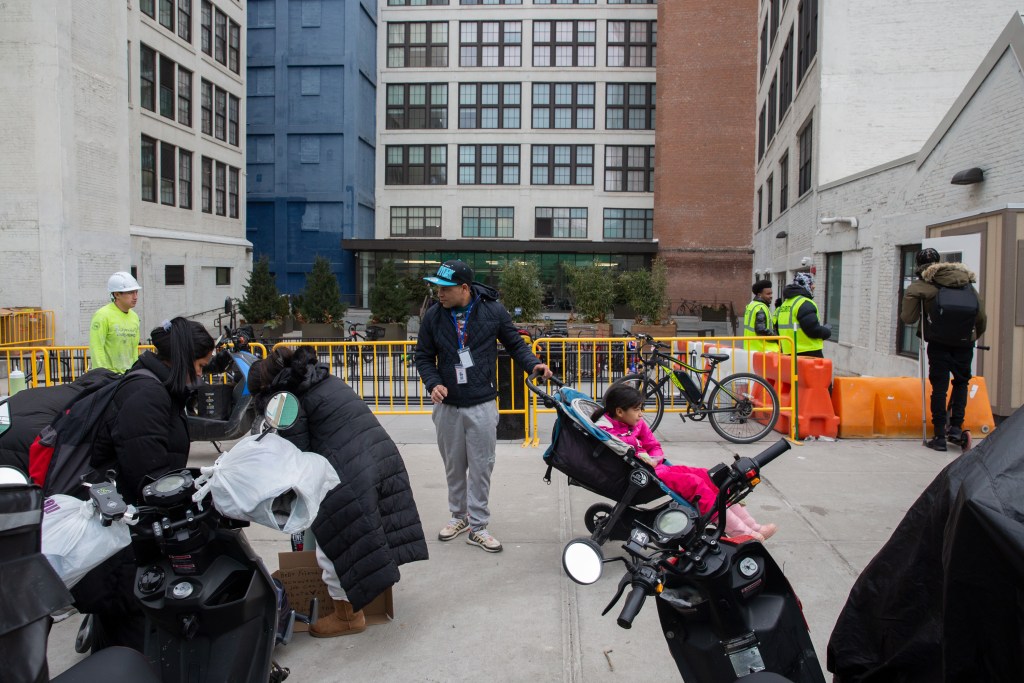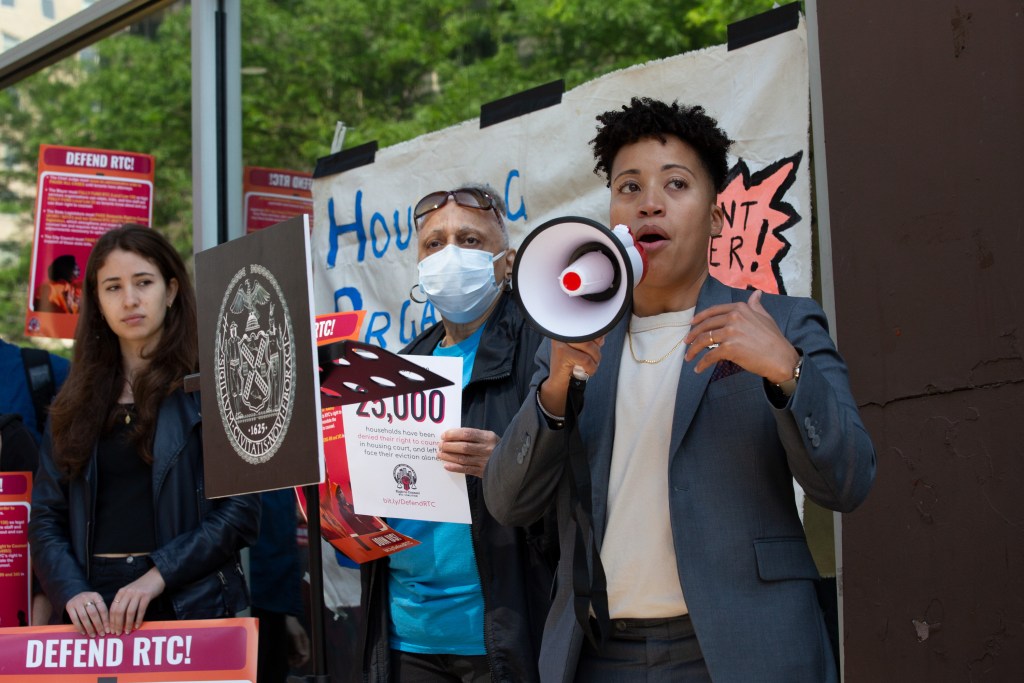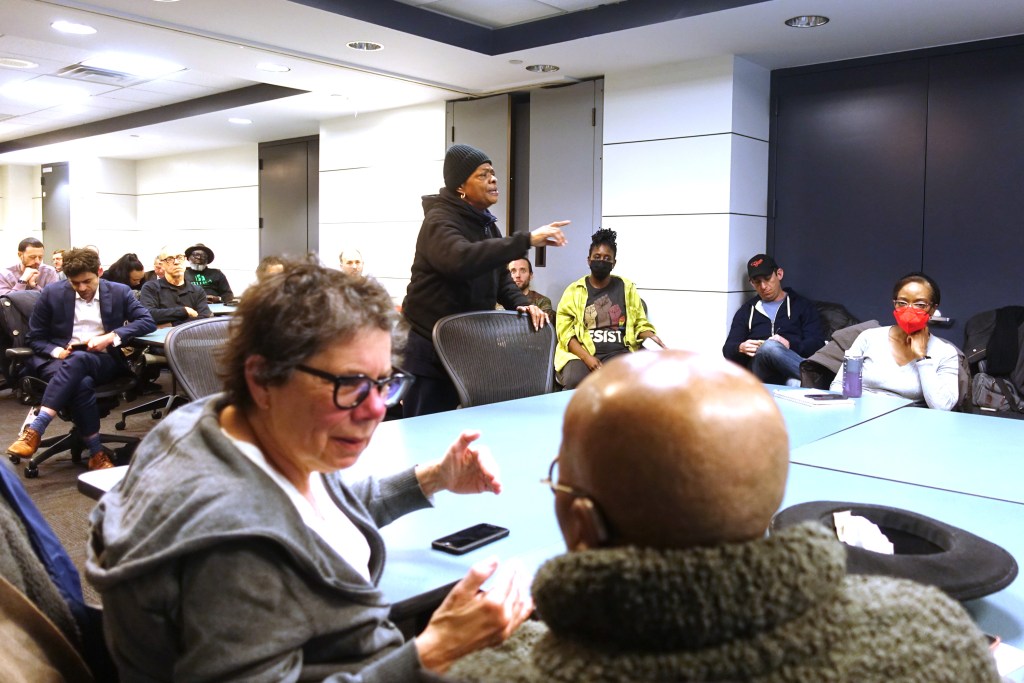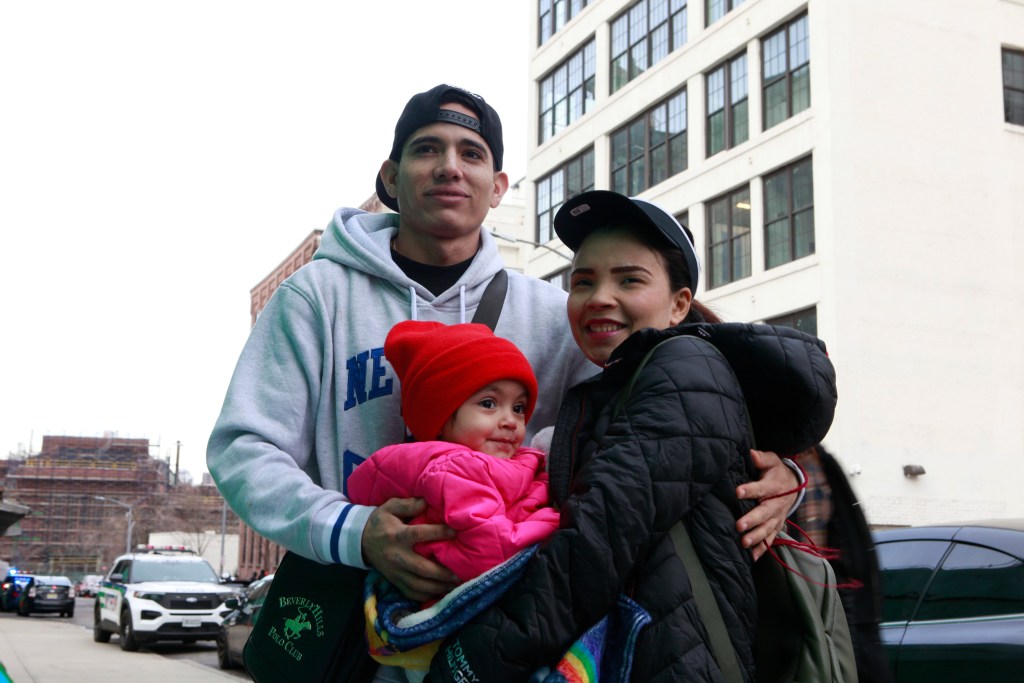Brooklyn’s Hall Street Migrant Shelter Grows to 3,000, Testing Neighbors in Clinton Hill
Some have welcomed the influx of migrants, which now include children enrolled in nearby schools. Others have complained about an increase in trash, loitering, noise, and street activity.

Workers bring supplies to the Hall Street migrant family shelter in Brooklyn, February 21, 2024. Photo by Ben Fractenberg/THE CITY
This article was originally published on by THE CITY
A massive migrant shelter in a complex of converted warehouses on Hall Street in Clinton Hill that opened last summer with no public announcement has since grown to house around 3,000 people.
Officials with the city’s Health + Hospitals recently told the local community board that the 10-building complex, adjacent to Brooklyn Navy Yard, has the capacity for as many as 6,000 people in another four buildings on the block, while a warehouse across the street overseen by the Department of Homeless Services could house hundreds more migrant families.
The quiet growth of the shelter complex in recent months has sent shockwaves across the surrounding residential neighborhoods. Local schools have taken on the sudden surge of new students, inspiring an outpouring of support. Community board meetings have bubbled up with residents raising concerns about trash, noise and loitering. Much as it has in other neighborhoods across the political spectrum, the influx of migrants has tested and divided Clinton Hill neighbors.
While many of the thousands of new residents are on strict 30- and 60-day clocks for their stays at the site, the massive shelter itself is something the residents of the surrounding area may have to cope with for years to come: The contract with property owner RXR Realty allows Health + Hospitals to use the location for as long as eight years.
Many residents agree the area has already been transformed, from a sleepy block people rarely strolled down unless they had an express reason to be there to a bustling street that wouldn’t be out of place in Midtown Manhattan. The impact has even made its way to Google Maps, where the address is now labeled “Brooklyn chester,” a Spanish phonetic of the spelling of the English word “shelter.”
“Hall Street was a no man’s land. It’s a dead end street. [Now] it’s like Grand Central Station,” said Monique Gramby, 55, a resident of the block for the past two decades.
“We’re understanding and sympathetic to the migrants’ plight, but at the same time, you’re really impacting our way of life,” she said.
‘Massive Unmet Need’
When the Hall Street shelter first opened last July, it housed only adult migrants. That changed in the last days of December, as city officials opened up additional buildings, dividing cavernous industrial spaces with partitioned cubicles, in which hundreds of families now sleep in the city’s second quasi-dormitory style setting for facility for parents and children.
In January, after the holiday break, dozens of newly arrived migrant children showed up with their parents to the doors of PS/IS 157 in Bedford-Stuyvesant a few blocks from the shelter. Within a matter of days, the school had more than 100 new students.
In years of gentrification and the COVID-19 pandemic, the number of students at PS/IS 157’s had gone from 417 students in the 2018-2019 school year to just 270 last school year. Now, in a matter of days, their numbers were back up, just shy of pre-pandemic levels. The school’s principal, Kourtney Boyd, told THE CITY that taking on the surge of new students has been amazing.
“If we don’t have kids running through our building, learning in our building, we have no purpose,” Boyd said. “It feels like we’re doing the work that we were chosen to do.”

Parents and teachers at the school quickly realized both the arriving children and their parents lacked basic items, from winter coats to underwear. They first started emptying their own closets to donate clothing, then asked the wider community for help.
“People in the broader neighborhood were seeing families digging in the trash on snowy days, desperately looking for food and items,” said Sara Nordmann, a parent at the school. “The whole community was seeing a massive unmet need.”
The donations flooded in. Overnight an anonymous donor shipped $800 worth of brand new Land’s End Jackets. Box after box of brand new items showed up at the school’s doorstep.
“Oh my God, where are we gonna put all this?” wondered Edwin Martinez, a bilingual custodian and teacher’s aide who has worked at the school for 18 years. Staff and parents landed on opening a free store of sorts in an empty classroom.
Martinez, who is a lifelong neighborhood resident, said it was inspiring to see the help flood in. “My father always instilled in me to give back, especially to people that really need it,” he said. “It became a wildfire.”
But since many of the families newly enrolled at PS/IS 157 had already received their 60-day notices that they must leave the shelter, it’s unclear if the students will remain there for long. A spokesperson for the school’s Department of Education barred Boyd from speaking about City Hall’s 60-day shelter ejection policy.
Andreina Zambrano, 30, Venezuelan mother of two elementary schoolers who’d recently enrolled at P.S/I.S. 157, told THE CITY that her family’s shelter time is slated to expire on Saturday.
“We still don’t have enough to rent. They like the school here,” she said in Spanish, of her two elementary schoolers enrolled. “I don’t know what we’ll do.”
“Last week, a lot of families left who were on the same floor as me — and they didn’t come back,” she said.
‘Too Many People’
Outside the school’s walls, tensions have mounted among some shelter neighbors, with complaints of trash, noise, loitering, disputes with shelter staff who change shifts early in the morning, and scores of men hanging out at nearby playgrounds and basketball courts. Local City Councilmember Crystal Hudson’s office has fielded the brunt of them. At first, she said, the comments were outright xenophobic.
“It was like, ‘Oh all these guys are here and I don’t feel safe walking to my car,’ and it’s kind of like, ‘OK, but did they say anything to you?’”

But lately, Hudson has heard more practical qualms about trash and late night moped ruckus. Her office funded additional trash pick-ups around the site, and tried to raise other issues with the administration of Mayor Eric Adams.
Hudson also said there’s been a surge in street homelessness under the nearby Brooklyn-Queens Expressway, prompted when shelter residents get kicked out for rule violations or evicted after their 30 days have expired.
“We’ve shared all of our concerns and the concerns of our constituents with the administration and are left sort of to fend for ourselves,” she said.
Frustrations bubbled up at a community board meeting in downtown Brooklyn on Feb. 7. It was the first time local residents had the chance to talk directly to representatives from Health + Hospitals, which runs the shelter.
“It’s too many people in one community,” said Adam Simon at the meeting, who has lived on Hall Street for more than 20 years. “This is the first chance to even tell you what our problems are.”
Hall Street resident Karen Marshall Hicks stood up at the meeting and said that someone had rifled through her mail and stolen a scooter from in front of her house. During another incident, when two men sitting on her stoop refused to leave, she said she took matters into her own hands. Hicks admitted to throwing bleach on them, while insisting she didn’t “want to call them animals.”

“I opened my window, got my bleach and I threw it on his ass, excuse my French,” she continued. “The neighborhood’s been destroyed, the quality of life, we had a very nice block. Hall Street was one of the best blocks in the neighborhood.”
Laura Atlas, a senior director for the Health + Hospitals, pushed back at the meeting on concerns that the facility is too large, saying it is on par with other large-scale migrant shelters the agency runs in Times Square or at Brooklyn’s Floyd Bennett Field.
“I think the critical context here is that in an emergency when you’re seeing 1,000 of people a day who don’t have a place to go, we couldn’t say, ‘Sorry, we’re just out of room, you’re gonna have to sleep on the street,” she said. “We never saw families sleeping on the street.”
After the meeting, Health + Hospitals officials agreed to meet quarterly with residents to hear their concerns and set up an email address neighbors can use to flag issues. They also brought several neighbors, a member of the community board and Councilmember Hudson on a site tour.
“When the Hall Street site opened as a humanitarian center, our leadership provided multiple tours of and briefings about the site with local representatives and community groups,” Adam Shrier, a spokesperson for Health + Hospitals, said in a statement to THE CITY. “We continue to maintain open and frequent communication with community stakeholders through regularly scheduled meetings and email correspondence.”
‘We’re Like Prisoners’
Inside the Hall Street shelter, parents and children sleep on cots in cubicles, sharing bathrooms and a cafeteria. Complaints about the food are constant. The overhead fluorescent lights shut off to all rooms at 8 p.m.
“There are a lot of sick kids coughing. You hear everything, talking, children crying,” said Cristofer Hernandez in Spanish. A 24-year-old father of two from Venezuela, Hernandez moved into the shelter with his wife and their two and four-year-old children, soon after it opened in late December.

“You can’t sleep or rest, and at 6 a.m. they turn on the lights military-syle,” he said. Even so, he remains grateful, adding, “We give thanks we have a roof over our heads here.”
In other buildings on the complex, adults without children sleep on cots pressed up against one another by the hundreds.
“We’re like prisoners here,” said Lemine, a 29-year-old from Mauritania, said in French. He asked that his last name not be published out of concern for immigration consequences. Lemine had spent 30-day stints in four other New York City shelters before getting reassigned to Hall Street in early February.
“To tell you the truth, we’re exhausted. We can’t work. The food is bad,” he said. “They treat you bad here. But we don’t have another choice. It’s really hard.”
‘A Humanitarian Corridor’
Along Hall Street, the shelter complex is a constant subject of conversation among neighbors. Some fret about wanting to pack up and sell their homes. Others are regularly involved in distributing clothes and food. Still more are organizing to pressure city agencies to improve trash collection and come up with more recreational space so shelter residents have other places to go besides hanging out on the blocks outside the shelter.
A constant flow of people walk to and from area bus and subway lines, begging for change, asking for work, collecting cans and selling foraged items.
“It feels like a humanitarian corridor,” said Kevin Ley, a 51-year-old neighbor, on a recent afternoon. “We’re not going to the playgrounds anymore. There’s like no space for the neighbors that live here, even on the benches.”
Ragnar Naess, 82, a Hall Street resident who has lived on the block for the past two decades, said that the conditions migrants faced in their home countries, the difficult journey to New York, and the cramped quarters they currently face in the old warehouses bring him to tears. All of that paled in comparison to quality of life concerns, like more garbage on the block than before, he said.

“The amount of trash they drop is minuscule. Look, there’s orange peels today,” he said, gesturing at the remnants of discarded fruit in a tree pit adjacent from his stoop. “So I pick up the fucking orange peels. Give me a break.”
THE CITY is a nonprofit newsroom that serves the people of New York. Sign up for our SCOOP newsletter and get exclusive stories, helpful tips, a guide to low-cost events, and everything you need to know to be a well-informed New Yorker.
Related Stories
- Former Gowanus Brewery, Clinton Hill Warehouse Slated to Become Migrant Shelters
- Migrants Sell Snacks in Downtown Brooklyn While Waiting on Work Permits
- For Families at Floyd Bennett Field, Getting Used to the Cold Is the Hardest Part
Email tips@brownstoner.com with further comments, questions or tips. Follow Brownstoner on Twitter and Instagram, and like us on Facebook.









What's Your Take? Leave a Comment